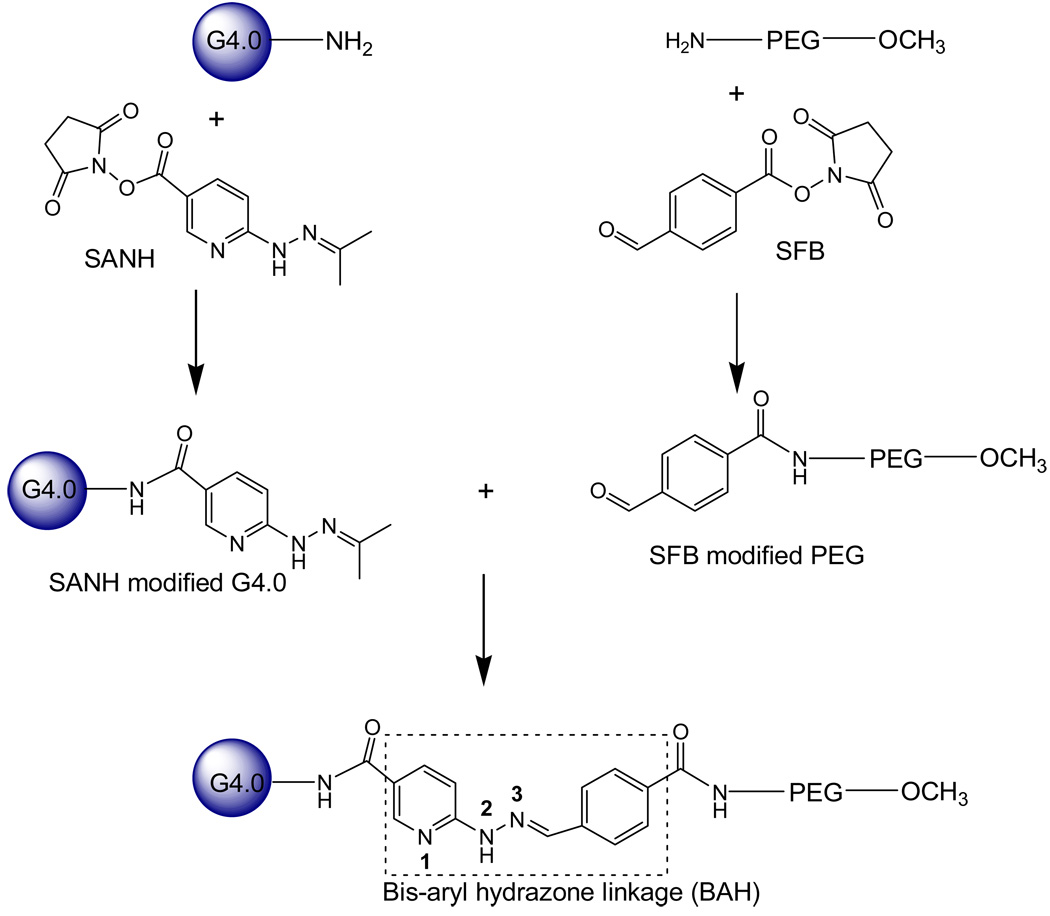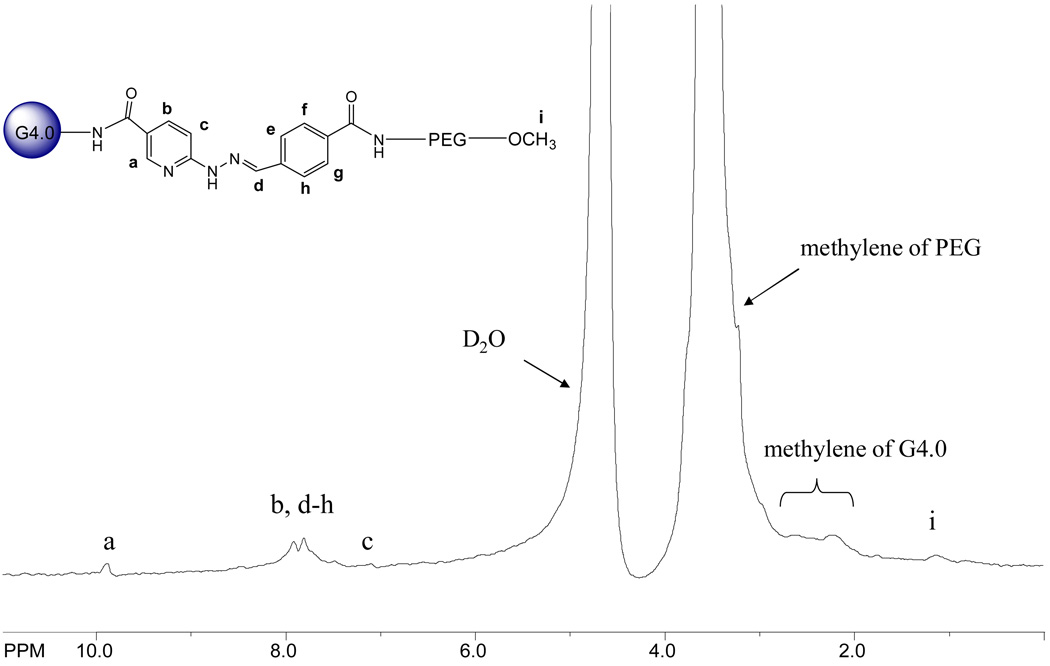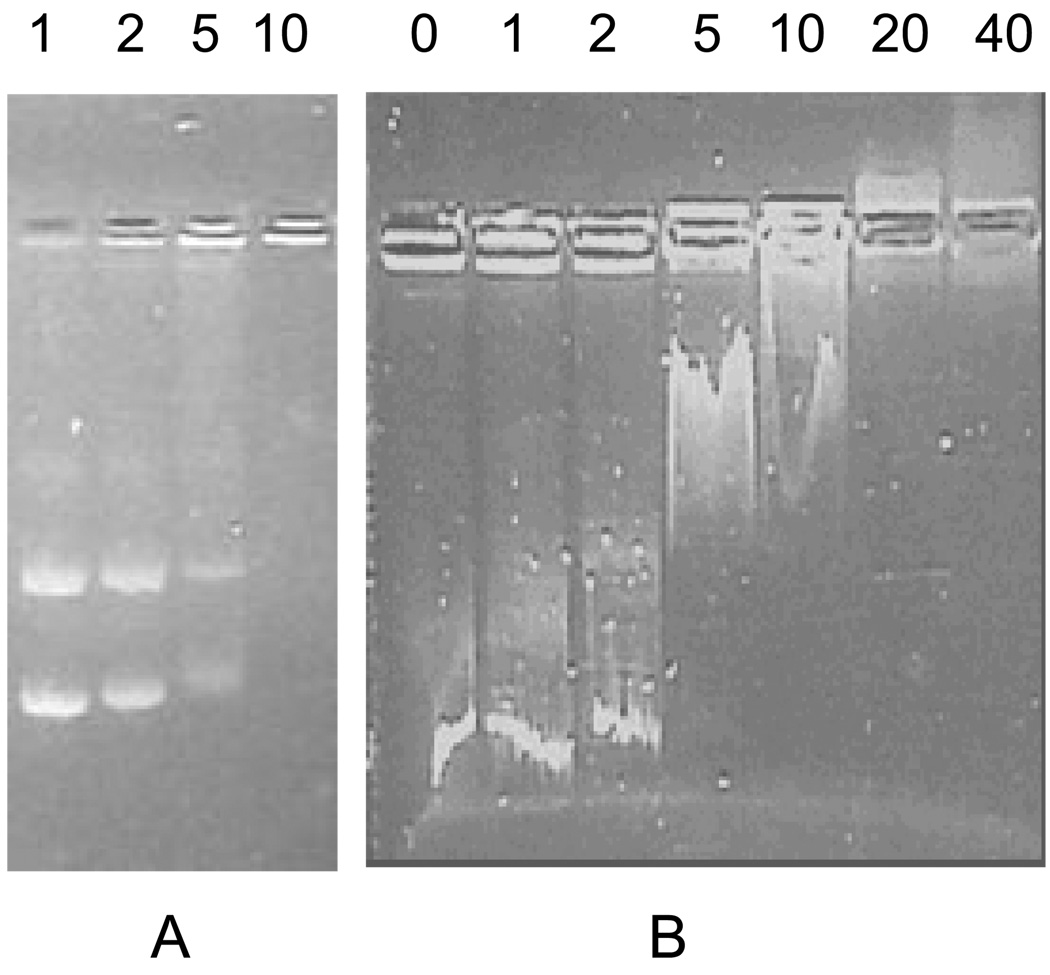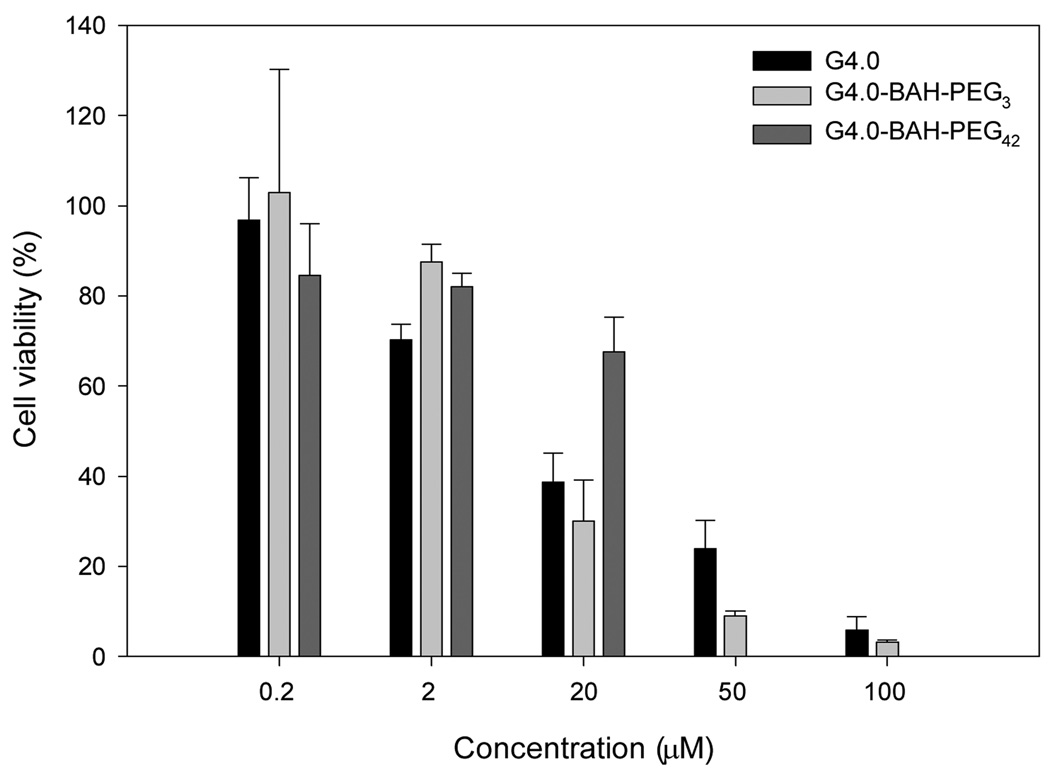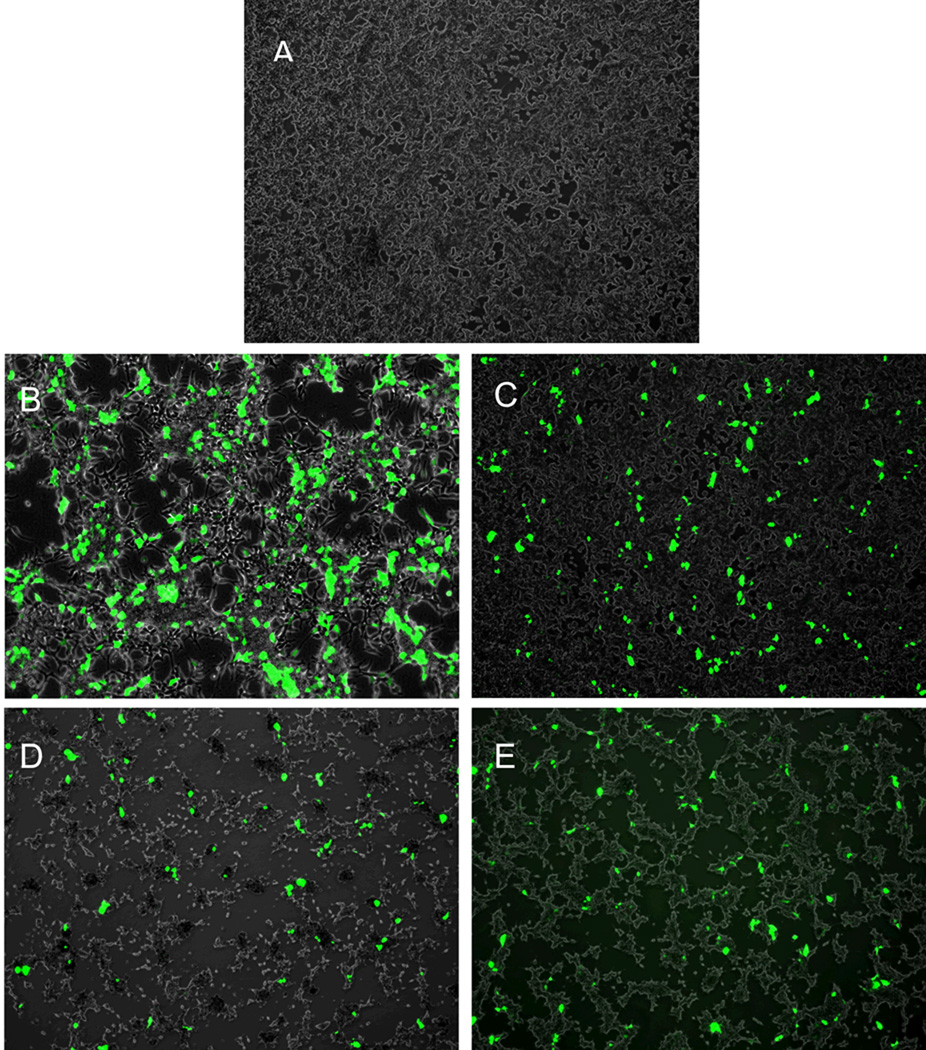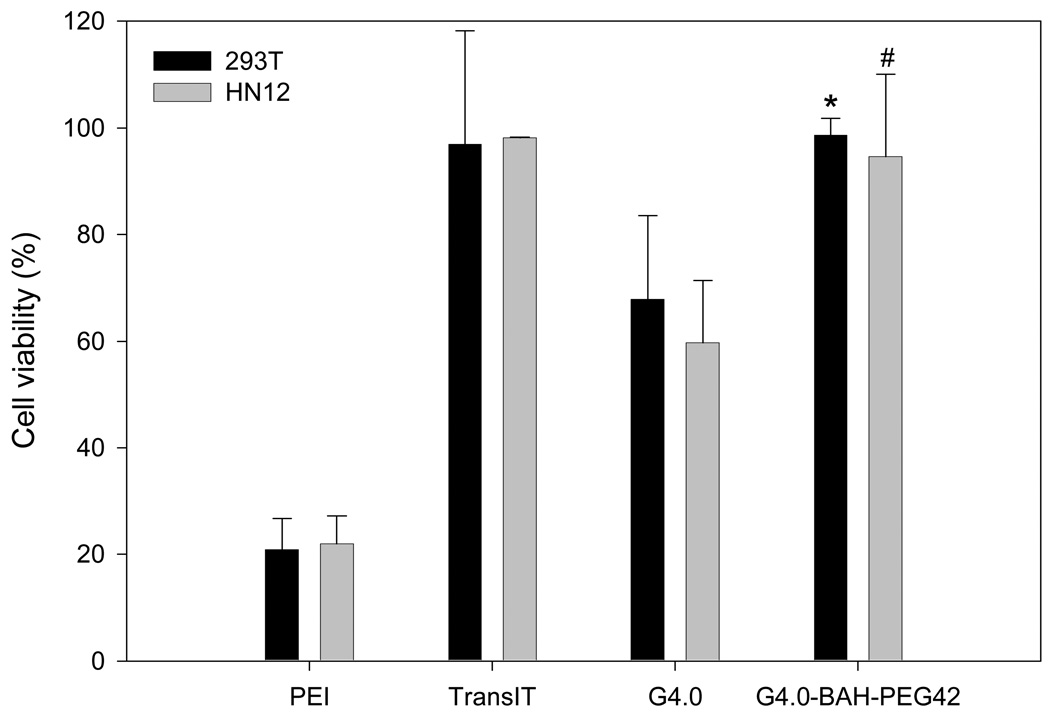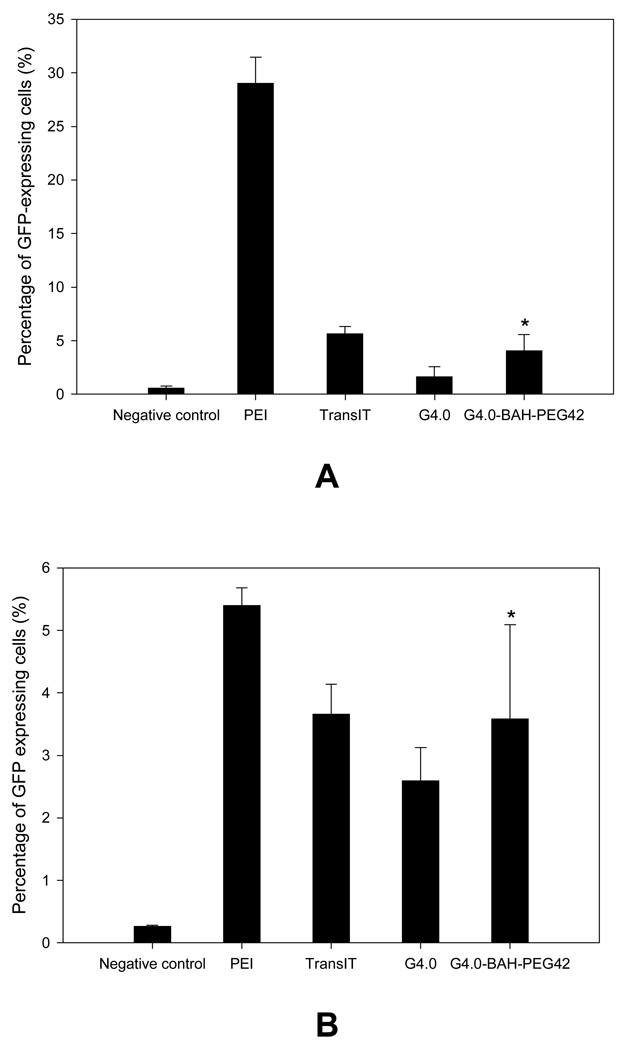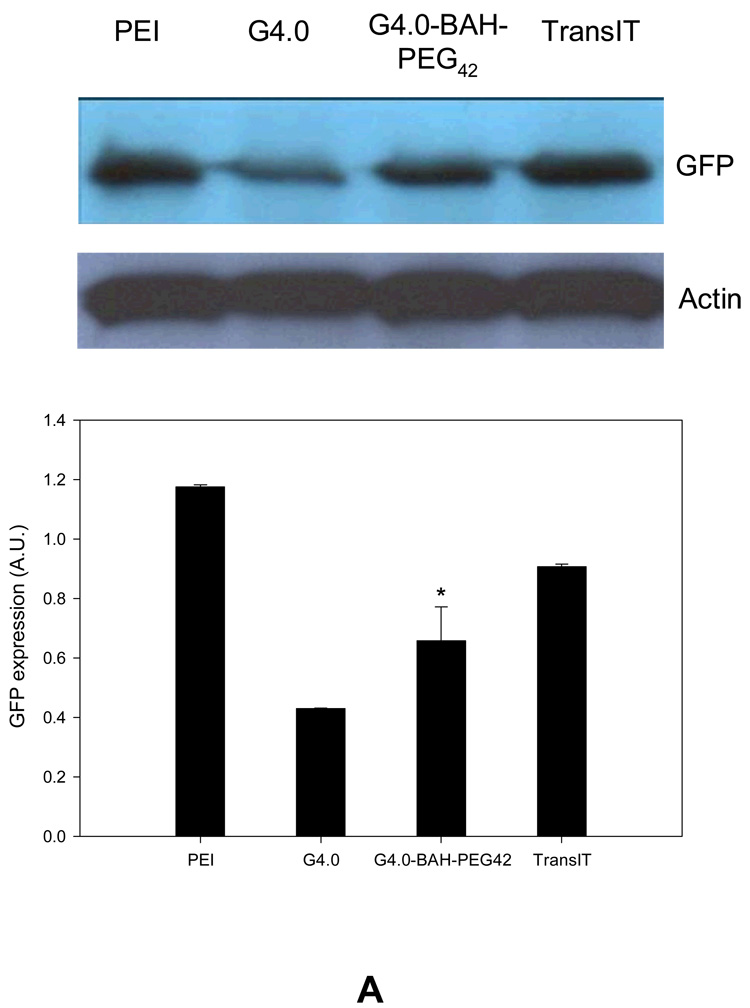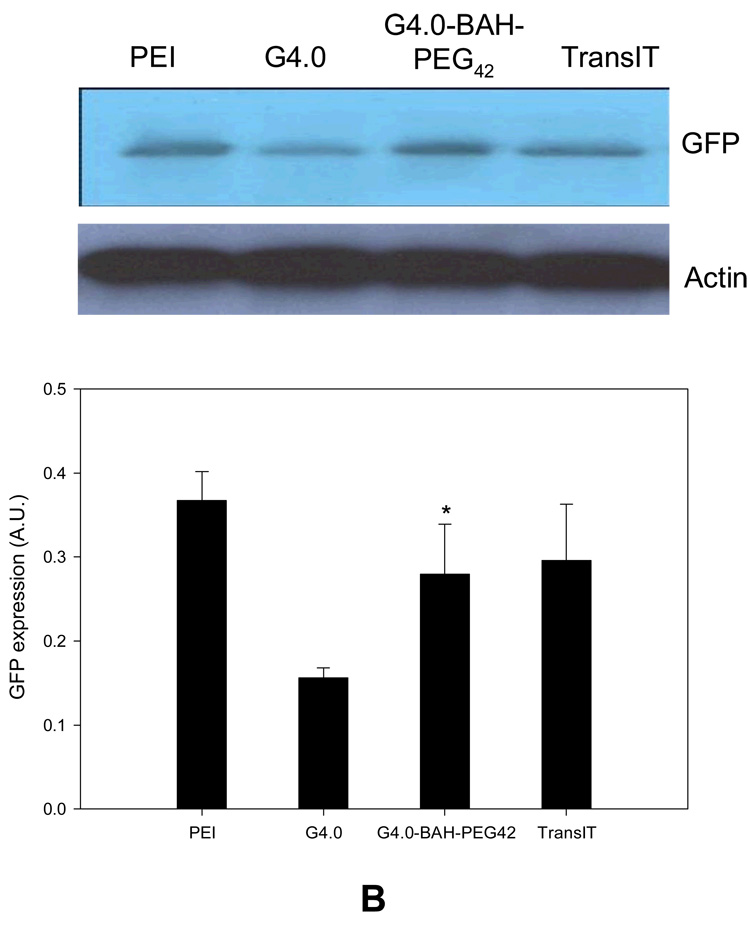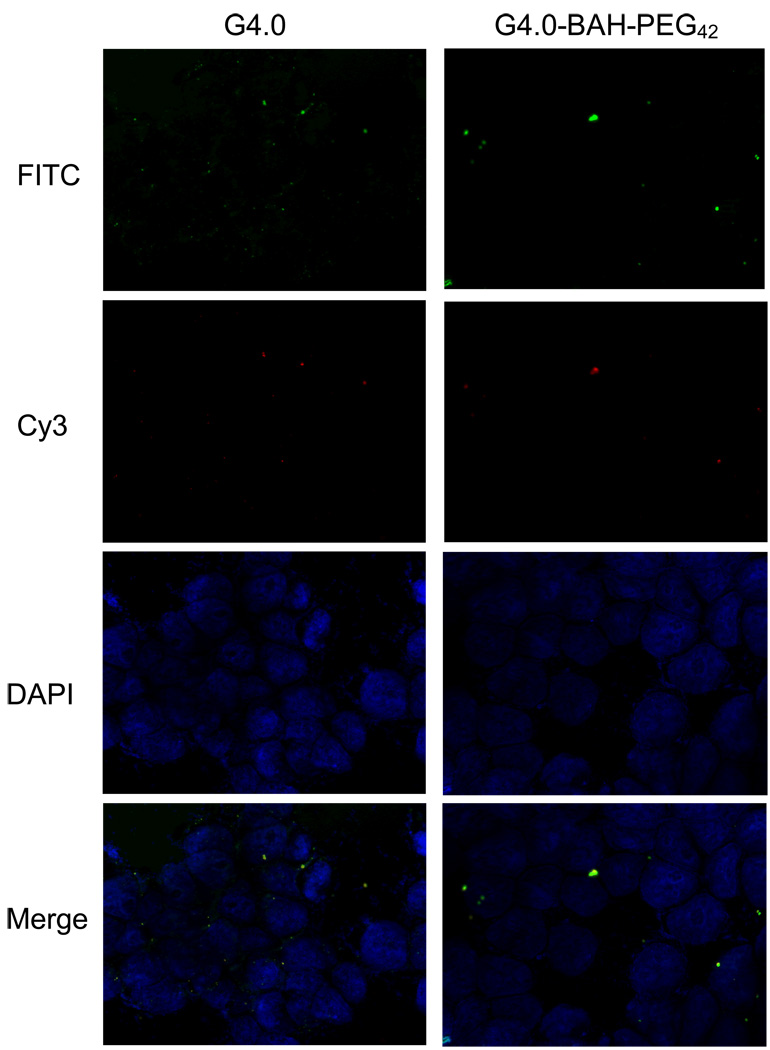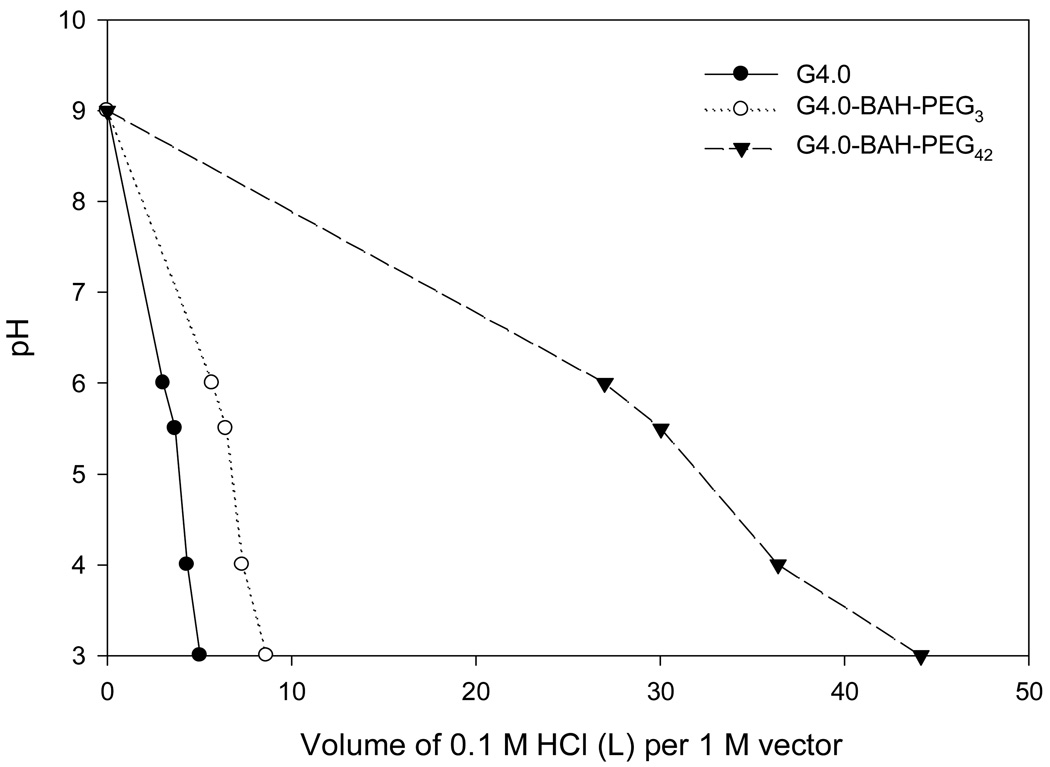Abstract
Surface modification of polyamidoamine (PAMAM) dendrimers with polyethylene glycol (PEG) often results in the decrease in their buffering capacity, which is essential for gene transfer. In this work, bis-aryl hydrazone bond, which possesses protonatable pyridine and amines, was explored as a new linkage for PEGylation of PAMAM dendrimers. PEGylated polyamidoamine (PAMAM) dendrimer G4.0 conjugates with bis-aryl hydrazone (BAH) linkages were synthesized following a two-step procedure: activation of PAMAM dendrimer G4.0 and monofunctional methoxypolyethylene glycol amine (MW=5000 Da) with succinimidyl 4-hydrazinonicotinate acetone hydrazone (SANH) and succinimidyl 4-formylbenzoate (SFB), respectively, and coupling of SFB-activated PEG to SANH-activated G4.0 to generate PEGylated G4.0 with bis-aryl hydrazone linkages (G4.0-BAH-PEG). It was found that the incorporation of BAH linkages into the vector significantly enhanced the buffering capacity of the vector even with a high degree of PEGylation (42 PEG chains per dendrimer). G4.0-BAH-PEG conjugates could complex with DNA plasmid tightly at low weight ratios and display dramatically improved cytocompatibility. According to gene transfection studies in 293T and HN12 cells, this new vector has been shown to be capable of both transfecting more cells and inducing higher gene expression than the parent dendrimer. This work demonstrates that the use of the BAH linkage in coupling of PEG to the dendrimer helps maintain or increase the buffering capacity of the functionalized dendrimer and results in enhanced transfection.
Keywords: bis-aryl hydrazone linkage, buffering capacity, dendrimer, gene delivery, polyethylene glycol, PEGylation
1. Introduction
Synthetic non-viral vectors, particularly cationic polymers, have attracted considerable attention for gene transfer as they can potentially avoid toxicity and immunogenicity, provide high DNA carrying capacity, achieve prolonged gene expression, and allow low-cost manufacturing.1–5 However, the lack of adequate functions to overcome multiple extra- and intra-cellular barriers is the major reason why synthetic vectors are far less efficient than viral vectors and have limited clinical utility to date. The evolving understanding of potential barriers to gene delivery, for example polyplex unpackaging,6, 7 has led to development of a number of synthetic vectors having various functionalities to improve gene transfection efficiency. Developing multifunctional non-viral vectors has become an important goal in order to endow them with transfection efficiency approaching that of viral vectors.
Amine-terminated polyamidoamine (PAMAM) dendrimers appear to be an ideal class of building blocks for developing multifunctional vectors, not only because of their well-defined highly branched structures and a number of surface groups available for assembly of many different types of functional entities but because of a number of inherent properties desirable for gene delivery.8–18 Polycationic dendrimers can stably form polyplexes with nucleic acids and facilitate their efficient internalization, mainly through endocytosis. The endocytic pathway begins near the physiological pH of 7.4, drops to a lower pH (5.5–6.0) in endosomes, and approaches pH 5.0 in lysosomes.19 Owing to the large buffering capacity conferred by a number of primary surface amines and tertiary amines inside the core, dendrimers can act as a “proton-sponge” to facilitate the escape of polyplexes from endosomes or lysosomes in an acidic environment.4
In addition to the extensive use of commercially available PAMAM dendrimers, a number of new or engineered PAMAM dendritic structures, such as PEGylated PAMAM dendrimers, reducible hyperbranched poly(amidoamine)s with disulfide bonds,20 polycationic PAMAM esters with grafted arginines,21 and PAMAM dendrimers with a new core, 22, 23 have been developed as new vectors for enhanced gene transfection. PAMAM dendrimers with polyethylene glycol (PEG) arms, namely PEGylated PAMAM dendrimers, are a group of dendrimer derivatives that have important biomedical and pharmaceutical applications.24 The incorporation of PEG chains into the dendritic structure can yield a number of biologically and pharmacokinetically desirable properties such as improved biocompatibility, reduced immunogenicity, prolonged half-life, increased water solubility, and enhanced structural stability, as reported in previous work.25–31 The use of PEGylated PAMAM dendrimers for gene transfection has been demonstrated. Luo et al. conjugated PEG to PAMAM dendrimer generation 5 (G5.0) via a stable amide linkage and observed its high efficiency in transfecting Chinese hamster ovarian cells.32 Recent work by Qi et al. revealed that the degree of PEGylation is an important variable affecting the transfection efficiency of PEGylated PAMAM dendrimers.33 PAMAM-block-PEG-block-PAMAM 34 and transferrin-coupled PAMAM-PEG 25 have also been developed to enhance transfection efficiency and specificity, respectively.
Because of the occupancy of the primary surface amine groups, surface modification of amine-terminated dendrimers by PEG potentially impairs the buffering capacity of the modified dendrimer, which, in turn, may result in unsatisfactory transfection efficiency.4 To ensure high transfection efficiency, high weight ratios of vector to plasmid are therefore needed, for example 250–1200:1 (w:w) for PAMAM dendrimer G5.0 conjugated with 14 PEG chains (MW=3400 gmol−1) through amide bonds.32 Although a viable approach is to minimize the degree of dendrimer surface modification, this strategy becomes questionable, particularly when a high degree of PEGylation is needed in order to keep the vector nontoxic for a long term and/or when the assembly of more functional groups is necessary for making the vector multifunctional. Therefore, the linkages connecting PEG or other moieties to the dendrimer are preferably not to compromise with the buffering capacity of the constructed vector. The impaired buffering capacity of dendritic vectors by the surface modification has not been addressed before. To this end, we employed a stable bis-aryl hydrazone (BAH) linkage for coupling of PEG to the dendrimer. The BAH linkage contains a protonatable pyridine and two protonatable amines,35 the use of this new linkage not only compensates for the loss of surface amines due to modification but provides an additional site for protonation, making it possible to enhance the buffering capacity of the vector even with a high degree of surface modification. In this work, PEG chains were grafted to PAMAM dendrimer G4.0 via bis-aryl hydrazone linkages. The fundamental aspects of the constructed PEGylated PAMAM dendrimers having bis-aryl hydrazone linkages including synthesis, characterization, and transfection efficiency were examined.
2. Materials and Methods
2.1. Materials
Polyamidoamine (PAMAM) dendrimer ([Core: ethylene diamine (EDA)]; [G=4]; [dendri-poly(amidoamine)-(NH2)64]) was purchased from Dendritech (Midland, MI). Succinimidyl 4-hydrazinonicotinate acetone hydrazone (SANH) and succinimidyl 4-formylbenzoate (SFB) were purchased from Pierce (Rockford, IL). Monofunctional methoxypolyethylene glycol amine (NH2-PEG-OCH3, MW=5000 gmol−1) and PEI (25,000 gmol−1) were purchased from Sigma-Aldrich (St. Louis, MO). TransIT keratinocyte transfection reagent (referred to as TransIT) was obtained from Mirus Bio (Madison, WI). pBMN-I-GFP plasmid was a gift from Dr. Garry Nolan, Stanford University.36 pMAX-GFP plasmid was purchased from Lonza (Gaithersburg, MD). Anti-GFP (B-2) and anti-actin (sc-1616) antibodies were purchased from Santa Cruz Biotechnology (Santa Cruz, CA). Horseradish peroxidase conjugated goat anti-mouse and rabbit anti-goat secondary antibodies were purchased from MP Biomedicals (Solon, OH). Dulbecco’s modified Eagle medium (DMEM) and fetal bovine serum (FBS) were purchased from Invitrogen (Carlsbad, CA). TransIT keratinocyte transfection reagent (referred to as TransIT) and Label IT® Cy3™ Plasmid Delivery Control (red) were purchased from Mirus Bio (Madison, WI). Polyvinylidene difluoride (PVDF) membrane (Immobilon-P) was purchased from Millipore (Billerica, MA). Western Lightning ECL was purchased from Perkin Elmer (Waltham, MA).
2.2. Synthesis of PEGylated PAMAM Dendrimers with Bis-Aryl Hydrazone (BAH) Linkages
As illustrated in Scheme 1, the synthesis involves two steps—activation of PAMAM dendrimer G4.0 and NH2-PEG-OCH3 (MW=5000 gmol−1) with SANH and SFB, respectively, and a subsequent coupling reaction between SANH-modified G4.0 and SFB-modified PEG. To modify G4.0 with SANH, 4.1 µmol of SANH in 2 ml of DMF was added to 2 ml of modification buffer (100 mM phosphate, pH 7.4) containing 0.085 µmol of PAMAM dendrimer G4.0. The reaction mixture was stirred for 6 hours. To modify NH2-PEG-OCH3 with SFB, 2 ml of DMF containing 4.1 µmol SFB was slowly added to 2 ml of modification buffer, in which 4.1 µmol of NH2-PEG-CH3 was dissolved. The reaction proceeded for 6 hours. Once the modification of NH2-PEG-OCH3 and G4.0 was complete, the solutions containing SANH-modified G4.0 and SFB-modified PEG were mixed, where the molar ratio of SFB-modified PEG to SANH-modified G4.0 could be varied in order to obtain different degrees of PEGylation on the dendrimer surface. The reaction was allowed to proceed overnight while stirring. The resultant G4.0 tethered with 42 PEG chains via bis-aryl hydrazone linkages (referred to as G4.0-BAH-PEG42) was purified by dialysis against deionized water and then freeze-dried. Following the same chemistry, G4.0 tethered with 3 PEG chains via bis-aryl hydrazone linkages (i.e., G4.0-BAH-PEG3) was also obtained.
Scheme 1.
Synthesis of G4.0-BAH-PEG conjugates.
2.3. 1H-NMR Spectroscopy
1H-NMR spectra were recorded on a Varian superconducting Fourier-transform NMR spectrometer (Mercury-300). Deuterium oxide (D2O, 99.9%) was used as the solvent. The chemical shift for D2O residue is 4.8 ppm.
2.4. Acid-Base Titration Assay
Each dendrimer sample (2.5 mg) was dissolved in 5 mL of 0.1M NaCl solution. The solution was adjusted to pH 9.0 with 0.1M NaOH and then titrated by adding small aliquots (25 µl, 10 µl, or 5 µl) of 0.1 M HCl until pH 4.0 was reached. The pH value was monitored using a pH meter. Buffering capacity of a vector is defined as follows: Buffering capacity =NExperimental/NTheoretical/M, where NExperimental is the experimental moles of titrant added to buffer solution over pH change, NTheoretical is the theoretical change in moles of H+ over the same pH change, and M is molarity. The pH change from 5.5 to 6.0, which mimics the acidic environment in late endosomes,37 was used for the calculation.
2.5. Gel Retardation Assay
The formation of G4.0-BAH-PEG/DNA polyplexes was examined by electrophoretic mobility in an agarose gel. The polyplexes were formed by mixing dendrimer vector with 1 µg of GFP plasmid at different weight ratios ranging from 0 to 40 in 50 µl of Dulbeccos’s modification of Eagle’s medium (DMEM). The mixtures were incubated in HEPES buffer (25 mM, pH 7.4) for 20 minutes at room temperature and subjected to electrophoresis (100V, 1 h) in an agarose gel (1%) stained with ethidium bromide (0.5 µg/ml).
2.6. Cell Culture
Two cell lines, HN12 38 and 293T, were used in this work. They were maintained at 37 °C in a humidified atmosphere containing 10% CO2 and 90% air in growth medium composed of DMEM supplemented with fetal bovine serum (10%) and penicillin-streptomycin (100 units/ml).
2.7. Cytotoxicity Assay
To determine the cytotoxicity of G4.0-BAH-PEG conjugates, the HN12 cells were seeded at a density of 5×103 cells/well in a 24-well cell culture plate at 37 °C. The cells were allowed to grow for 24 hours. Afterwards, growth medium was replaced with 1 ml of fresh medium containing G4.0-BAH-PEG at different concentrations (0.2–100 µM). G4.0 was used as a control. At 48 hours, cell viability was determined in triplicate using the Trypan blue dye exclusion assay.
2.8. In Vitro Transfection
293T cells and HN12 cells were seeded in 6-well plates at a density of 5×104 cells/well and allowed to grow in 2 ml of growth medium containing 10% FBS for 24 hours prior to transfection. The cells kept in the growth medium containing 10% FBS were then transfected with the polyplexes of G4.0-BAH-PEG/GFP plasmid (100 µg/1 µg), G4.0/GFP plasmid (100 µg/1 µg), PEI/GFP plasmid (20 µg/1 µg), and TransIT/GFP plasmid (5 µl/1 µg), which were pre-dissolved in 100 µl of serum-free DMEM medium. After 6-hour transfection treatment, the medium in each well was replaced with 2 ml of fresh growth medium containing 10% FBS. The cells were further incubated for 48 hours and then evaluated for transfection outcomes.
2.9. Western blot
After the growth medium was removed, cells were washed twice with ice-cold DPBS and lysed on ice for 10 minutes using 60 µl of cell lysis buffer (20mM HEPES, pH 7.5, 10mM EGTA, pH8.0, 40mM β-glycerophosphate, 1% NP-40, 2.5mM MgCl2, 20µg/ml aprotinin, 20µg/ml leupeptin, 1mM PMSF), scraped immediately, and transferred to sterile 1.5 mL microcentrifuge tubes. Supernatant was transferred to a fresh microcentrifuge tube after 10 min of microcentrifugation at 10,000 g at 4 °C. Cleared lysates were quantified using a modified Bradford assay (BCA; Biorad, Hercules, CA), and equivalent amounts of protein were resolved by SDS-PAGE and then transferred to polyvinylidene difluoride (PVDF) membrane (Immobilon-P; Millipore, Billerica, MA). Membranes were blocked in 5% skimmed milk in TTBS (10 mM Tris-HCl, pH 7.6, 0.5% Tween-20, 150 mM NaCl) for 1 h at room temperature, and then incubated in primary antibodies diluted 1:1000 in blocking buffer overnight at 4 °C. After washing in TTBS, bound primary antibodies were detected using horseradish peroxidase conjugated secondary antibodies and Western Lightning Enhanced Chemiluminescence (ECL; Perkin-Elmer, Waltham, MA).
2.10. Fluorescence Microscopy
True-color fluorescent images of the cells transfected with pMAX-GFP plasmid were taken using a Zeiss Axiovert 200 inverted fluorescence microscope (Carl Zeiss Microimaging, Thornwood, NY).
2.11. Flow Cytometry
Following the removal of the old growth medium, transfected cells were washed twice with ice-cold DPBS and re-suspended using trypsin for 5–10 min. The cells were fixed with cold 70% ethanol for 1 hour at 4 °C, then centrifuged and washed with DPBS, and transferred to microcentrifuge tubes containing 500 µl of PBS. Afterwards, the cells were incubated with 1µg/ml RNase for 1 h at room temperature and stained with propidium iodide (50 µg/mL). The cells were then analyzed by using a Guava EasyCyte mini flow cytometry system (Millipore, Billerica, MA).
2.12. Intracellular Trafficking Studies
G4.0 and G4.0-BAH-PEG42 were labeled with fluorescein isothiocyanate (FITC) following our previous work.39 293T cells were seeded on borosilicate glass cover slips in 6-well plates at a density of 5×104 cells/well and allowed to grow in 2 ml of growth medium containing 10% FBS for 24 hours. The cells were incubated with the polyplexes of FITC-G4.0-BAH-PEG42 or FITC-G4.0 (control)/Label IT® Cy3™ plasmid (50 µg/0.5 µg in 100 µl of serum-free DMEM medium) for various lengths of time (i.e., 1h, 3h, and 6h), fixed with ice-cold methanol for 10 minutes, counterstained with DAPI, and then rinsed with PBS buffer. Additionally, 293T cells incubated with the polyplexes for 6 h were rinsed with PBS and then continuously cultured until 24 h or 48 h in 2 ml of fresh growth medium containing 10% FBS. They were then fixed with ice-cold methanol for minutes, counterstained with DAPI, and rinsed with PBS buffer. True-color fluorescent images of the transfected cells were taken under a Zeiss Axiovert 200 inverted fluorescence microscope.
2.13. Statistical Analysis
Data were analyzed by analysis of variance (ANOVA) followed by Student’s t-test for pairwise comparison of subgroups. P values <0.05 were considered statistically significant.
3. Results and Discussion
3.1. Synthesis of G4.0-BAH-PEG Conjugates
G4.0-BAH-PEG conjugates were synthesized according to Scheme 1. EDA core PAMAM dendrimer G4.0 containing 64 primary amine surface groups was chosen as the underlying core. Its structure and purity have been reported previously.40, 41 SANH is a hetero-bifunctional agent containing an amine-reactive NHS moiety and an aldehyde-reactive hydrazine moiety. SANH was used to modify the amine-terminated surface of G4.0 through its NHS moiety, hence introducing hydrazine moieties to the dendrimer surface. Meanwhile, the amine group of monofunctional NH2-PEG-OCH3 (5000 gmol−1) was converted to a benzaldehyde moiety. The monofunctional NH2-PEG-OCH3 was used here to avoid cross-reactions or loops that may form on the dendrimer surface. SFB-activated PEG was then coupled to SANH-modified G4.0 through the formation of a stable bis-aryl hydrazone linkage. The final product was dialyzed against deionized water for purification. The 1H-NMR spectrum of G4.0-BAH-PEG42 is shown in Figure 1. The spectrum confirms the presence of the methylene proton peaks of PEG (3.65 ppm, broad) and G4.0 (multiple methylene proton peaks between 2.4 ppm and 3.4 ppm). Methyl end group (i) of PEG appears at 1.3 ppm. In addition, multiple proton peaks of the BAH linkage appear between 7.2–10 ppm. According to the integration of the corresponding proton peaks of PEG and G4.0, G4.0 dendritic macromolecules tethered with an average of 3 or 42 PEG chains via bis-aryl hydrazone linkages were obtained and used for further studies. In addition, 1H-NMR spectroscopy was applied to characterize the products in acidic hydrolysis study. The degree of PEGylation remained unchanged even after 24 hour-incubation at pH 4.0, suggesting that the synthesized conjugates were resistant to acidic degradation.
Figure 1.
1H-NMR spectrum of G4.0-BAH-PEG42 (MW of PEG is 5000 gmol−1).
3.2. Buffering Capacity of G4.0-BAH-PEG
Efficient gene transfer mediated by PAMAM dendrimers is in part due to their high buffering capacity, which is responsible for the timely release of polyplexes from the endosome and the lysosome. High buffering capacity of PAMAM dendrimers is attributed to a large number of primary amine groups on the dendrimer surface and tertiary amine groups inside the core. An acid-base titration assay was performed to profile the buffering capacity of G4.0 and the synthesized PEGylated G4.0 with BAH linkages. In general, the higher the buffering capacity of a synthetic vector, the greater the resistance of its solution to pH change. In this work, the acid-base titration assay was performed to profile the buffering capacity of the dendritic vector solutions containing the same mass of vectors, which mirrored the preparation and use of the polyplexes in the gene transfection studies in this work. To decrease the pH value of the dendrimer solution (2.5 mg/5 ml) from 9 to 3, G4.0, G4.0-BAH-PEG3, and G4.0-BAH-PEG42 solutions need 178 µL, 144 µL, and 89 µL of 0.1 M HCl, respectively. This result suggests that they have sufficient resistance to pH change and are likely to be capable of facilitating the endosomal escape of polyplexes. In general, gene vectors should have sufficient buffering capacity over a pH range of 5.5–6.0 in order to permit polyplexes to escape from the endosome. The buffering capacity of G4.0-BAH-PEG conjugates over a pH range of 5.5–6.0 was calculated on the basis of molarity and compared to that of G4.0. The numerical calculation revealed that the buffering capacity of G4.0-BAH-PEG3 was increased by 17% and that of G4.0-BAH-PEG42 was increased by 377%. The increase in the buffering capacity of G4.0-BAH-PEG was attributed to the incorporation of bis-aryl linkages into the conjugates. As demonstrated, a higher percentage of PEGylation on the dendrimer surface with an enhanced buffering capacity was enabled with the incorporation of bis-aryl hydrazone linkages.
3.3. Analysis of Polyplex Formation
A gel retardation assay was performed to characterize the biophysical properties of G4.0-BAH-PEG vectors in terms of the stability of polyplex formation. G4.0-BAH-PEG conjugates were complexed with pMAX-GFP plasmid at various weight ratios (0–40). According to the gel retardation assay (Figure 3A), at a weight ratio of 10 or higher, the polyplexes of G4.0-BAH-PEG3/plasmid remain immobile, indicating that 10 is a minimal weight ratio for tightly condensing plasmid by G4.0-BAH-PEG3. The DNA plasmid showed complete retardation at a weight ratio of 20 or higher with G4.0-BAH-PEG42 (Figure 3B). This study illustrates minimal weight ratios required for G4.0-BAH-PEG vectors to neutralize the negatively charged GFP plasmid and form stable polyplexes. Since the efficient adsorptive uptake of polyplexes by cells would be enabled by the net positive charge of vector/plasmid polyplexes, a high weight ratio of vector to plasmid (i.e., 100) was employed in gene transfection studies.
Figure 3.
Gel retardation assay. (A) G4.0-BAH-PEG3/GFP plasmid complexes at weight ratios of 1, 2, 5, and 10 (left to right). (B) G4.0-BAH-PEG42/GFP plasmid complexes at weight ratios of 0, 1, 2, 5, 10, 20, and 40 (left to right).
3.4. Cytotoxicity
As shown in Figure 4, at 0.2 µM, none of G4.0, G4.0-BAH-PEG3, and G4.0-BAH-PEG42 induced an obvious cytotoxic response in HN12 tumor cells over a period of 48 hours. Over the same period of time, G4.0, G4.0-BAH-PEG3, and G4.0-BAH-PEG42 induced a similarly modest cytotoxic response at 2 µM. At 20 µM, G4.0- BAH-PEG42 still displayed much higher cytocompatability than G4.0 and G4.0-BAH-PEG3. It resulted in a decrease of 32% in cell viability compared to untreated controls. Because of the difficulty in dissolution at high mass, the toxicity of G4.0-BAH-PEG42 at 50 µM and 100 µM was not tested. At 20 µM or higher concentration, G4.0-BAH-PEG3 showed considerably higher cytotoxicity. Given that G4.0-BAH-PEG3 did not show improved cytocompatibility, G4.0-BAH-PEG42 was evaluated further in gene transfection studies.
Figure 4.
Dose-dependent cytotoxic effect of G4.0 (control) and G4-BAH-PEG conjugates on the viability of HN12 cells. HN12 cells were seeded in culture plates, exposed to the indicated concentrations of dendrimer conjugates, and cell viability at 48 h determined by the Trypan blue assay. The data are expressed as mean ± SD.
3.5. In Vitro Transfection Studies
The in vitro gene transfection efficiency of G4.0-BAH-PEG42 was evaluated using 293T and HN12 cell lines with GFP plasmids as reporters. PEI (25 kDa) is an efficient gene transfection agent and commonly used as a “gold standard” although it has appreciable toxicity. TransIT-keratinocyte transfection reagent (simply referred to as TransIT) is a commercially available transfection reagent with high efficiency and low toxicity. Both PEI and TransIT were used as controls in this work. To ascertain whether the use of the BAH linkage would result in improved gene transfection, G4.0-mediated gene transfection was evaluated for direct comparison. Although increasing vector to plasmid ratios very likely augments the gene transfection efficiency, cytotoxicity of the vector at high concentrations should also be balanced, particularly for PEI, which has high toxicity. Therefore, gene transfection of the vectors should be evaluated in conjunction with their potential toxic effects on transfected cells. PEI was complexed with GFP plasmid at a weight ratio of 20:1, which was shown to generate appreciably high gene transfection efficiency under the condition used in this work. The transfection efficiency was evaluated using GFP expression, which was qualitatively illustrated by fluorescence microscopy and quantified by both flow cytometery and western blot. The cell viability after transfection was assessed as well.
The fluorescence images of GFP-expressing 293T cells are shown in Figure 5. It is apparent that PEI-mediated gene transfer has resulted in the highest percentage of transfected 293T cells with the strongest fluorescence. The cellular morphology of the transfected cells remained unchanged, indicating the minimal toxic effect of PEI. TransIT-mediated gene transfer resulted in a moderate percentage of transfected 293T cells, which is similar to the outcome of gene transfection by G4.0-BAH-PEG42. In contrast, 293T cells are sparsely transfected when using G4.0. In addition, the 293T cells suffered from the toxicity of G4.0, which was confirmed by the cell viability assessment done after gene transfection studies (Figure 6). In contrast, the viability of the 293T cells treated with G4.0-BAH-PEG42 remained unchanged. Flow cytometry analysis revealed that the proportion of 293T cells transfected was 28.0% by PEI, 5.1% by TransIT, 1.1% by G4.0, and 3.5% by G4.0-BAH-PEG42 (Figure 7). The transfection efficiency of G4.0-BAH-PEG42 was three times that of unmodified G4.0 in terms of the percentage of transfected cells. Western blotting was used to quantify the levels of GFP expression in the transfected cells (Fig. 8). Again, the western blot results confirmed that G4.0 has the lowest transfection efficiency in terms of the ability to induce transgene expression in 293T cells (Fig. 8A). G4.0-BAH-PEG42-mediated gene transfer has resulted in an increase of 53% in the overall amount of GFP expressed in the 293T cells as compared to G4.0-medidated gene transfer. The gene transfection studies based on 293T cells showed that G4.0-BAH-PEG42 is able to transfect significantly more 293T cells and induce a higher level of GFP expression than unmodified G4.0.
Figure 5.
Fluorescence images of 293T cells (untreated, A) and 293T cells transfected with GFP plasmid mediated with PEI (B), TransIT (C), G4.0 (D), and G4-BAH-PEG42 (E). The cells were exposed to the vector/GFP plasmid polyplexes for 6 hours, rinsed, and then cultured for another 48 hours. Original magnification, ×100.
Figure 6.
Cell viability of 293T and HN12 post-transfection as determined by the Trypan blue assay. The cells were exposed to the vector/GFP plasmid polyplexes for 6 hours, rinsed, and then cultured for another 48 hours. The data are expressed as mean ± SD, * indicates p <0.05 versus G4.0 group in transfected 293T cells, and # indicates p <0.05 versus G4.0 group in transfected HN12 cells.
Figure 7.
Efficiency of transfection agents in 293T (A) and HN12 (B) as determined by flow cytometry. The cells in 2 ml of growth medium containing 10% FBS were exposed to the polyplexes (PEI/plasmid: 20 µg/1 µg; TransIT/plasmid: 5 µL/1 µg; G4.0/plasmid: 100 µg/1 µg; G4-BAH-PEG42/plasmid: 100 µg/1 µg) for 6 hours, rinsed, and then cultured for another 48 hours prior to flow cytometry analysis. Untreated cells were used as negative control. The data are expressed as mean ± SD, and * indicates p <0.05 versus G4.0 group.
Figure 8.
Western blot analysis of GFP expression in 293T (A) and HN12 cells (B). The cells in 2 ml of growth medium containing 10% FBS were exposed to the polyplexes (PEI/plasmid: 20 µg/1 µg; TransIT/plasmid: 5 µL/1 µg; G4.0/plasmid: 100 µg/1 µg; G4-BAH-PEG42/plasmid: 100 µg/1 µg) for 6 hours, rinsed, and then cultured for another 48 hours prior to western blot assay. GFP expression was quantified by using Quantity One (Bio-Rad) and normalized to actin of each group. The data are expressed as mean ± SD, and * indicates p <0.05 versus G4.0 group.
HN12 cells are difficult to transfect, and only a small proportion of HN12 cells were transfected regardless of transfection agents. According to the flow cytometry results, the percentage of HN12 cells transfected was 5.1% by PEI, 3.4% by TransIT, 2.3% by G4.0, and 3.3% by G4.0-BAH-PEG42 (Fig. 7). The GFP expression in HN12 cells transfected by G4.0-BAH-PEG42 was 80% more than those transfected by G4.0 (Fig. 8B). The western blot results indicate that the ability of G4.0-BAH-PEG42 was similar to that of TransIT in inducing GFP expression in HN12 cells.
Although the transfection efficiency of a vector significantly depends on the target cell type, G4.0-BAH-PEG42 showed higher transfection efficiency than G4.0 in both cell lines tested in the present study while exerting considerably less toxic effects on transfected cells, suggesting that the incorporation of bis-aryl hydrazone linkages into the PEGylated dendrimer vector indeed resulted in enhanced gene transfection. To understand the intracellular trafficking pattern of the internalized dendrimer/plasmid polyplexes in living cells, colocalization assays were performed to assess the distribution of the polyplexes in 293T cells at various time points post-transfection. The dendritic vectors (i.e., G4.0 and G4.0-BAH-PEG42) were labeled with FITC. A fluorescence-labeled plasmid (i.e., Label IT® Cy3™ plasmid) was employed for in vitro tracking of plasmid. Time lapse imaging and colocalization results qualitatively show the internalization of G4.0-BAH-PEG42/plasmid polyplexes was stronger than that of G4.0/plamid polyplexes within the first hour (Fig. 9). As time progressed, more polyplexes of G4.0/plasmid were internalized. However, the dissociation of G4.0/plasmid polyplexes became noticeable at 3h and 6h (Fig. 10). In contrast, G4.0-BAH-PEG42/plasmid polyplexes were still tightly complexed and found in the nuclei of 293T cells. The accumulation of G4.0-BAH-PEG42/plasmid polyplexes in the nuclei at 24 h (Fig. 10) and 48 h (not shown) became more evident as opposed to G4.0/plasmid polyplexes, which could be attributed to enhanced gene transfection.
Figure 9.
Intracellular trafficking of FITC-labeled dendrimer (green)/Label IT® Cy3™ plasmid (red) polyplexes in 293T cells at 1 h post-transfection. The cell nuclei were counterstained with DAPI (blue).
Figure 10.
Colocalization of FITC-labeled dendrimer (green)/Label IT® Cy3™ plasmid (red) polyplexes in 293T cells at various time points. The cell nuclei were counterstained with DAPI (blue).
4. Conclusions
PEGylated PAMAM dendrimer G4.0 conjugates with bis-aryl hydrazone linkages (i.e., G4.0-BAH-PEG) were successfully synthesized and evaluated as a new vector. The incorporation of bis-aryl hydrazone linkages into the vector significantly enhanced the buffering capacity of the vector even with a high degree of PEGylation (42 PEG chains per dendrimer). G4.0-BAH-PEG conjugates could complex tightly with plasmid DNA at low weight ratios and displayed dramatically improved cytocompatibility. According to the gene transfection studies based on 293T and HN12 cells, this new vector has been shown to be capable of both transfecting more cells and inducing higher GFP expression than unmodified G4.0. This work has demonstrated that the use of bis-aryl hydrazone linkage in coupling of PEG to the dendrimer helps maintain or increase the buffering capacity of the functionalized dendrimer and results in enhanced gene transfection.
Figure 2.
Acid-base titration assay. Solutions (5 ml) containing 2.5 mg of vector were adjusted to pH 9 with 0.1M NaOH and then titrated with 0.1 M HCl.
Acknowledgement
This research was supported, in part, by The Jeffress Memorial Trust (J-873) and the National Institutes of Health (R21NS063200).
References and Notes
- 1.Lim YB, Kim SM, Suh H, Park JS. Biodegradable, endosome disruptive, and cationic network-type polymer as a highly efficient and nontoxic gene delivery carrier. Bioconjugate Chem. 2002;13(5):952–957. doi: 10.1021/bc025541n. [DOI] [PubMed] [Google Scholar]
- 2.Mahato RI, Henry J, Narang AS, Sabek O, Fraga D, Kotb M, Gaber AO. Cationic lipid and polymer-based gene delivery to human pancreatic islets. Mol. Ther. 2003;7(1):89–100. doi: 10.1016/s1525-0016(02)00031-x. [DOI] [PubMed] [Google Scholar]
- 3.De Smedt SC, Demeester J, Hennink WE. Cationic polymer based gene delivery systems. Pharm. Res. 2000;17(2):113–126. doi: 10.1023/a:1007548826495. [DOI] [PubMed] [Google Scholar]
- 4.Pack DW, Hoffman AS, Pun S, Stayton PS. Design and development of polymers for gene delivery. Nat. Rev. Drug Discovery. 2005;4(7):581–593. doi: 10.1038/nrd1775. [DOI] [PubMed] [Google Scholar]
- 5.Luo D, Saltzman WM. Synthetic DNA delivery systems. Nat. Biotechnol. 2000;18(1):33–37. doi: 10.1038/71889. [DOI] [PubMed] [Google Scholar]
- 6.Little SR, Lynn DM, Ge Q, Anderson DG, Puram SV, Chen J, Eisen HN, Langer R. Poly-beta amino ester-containing microparticles enhance the activity of nonviral genetic vaccines. Proc. Natl. Acad. Sci. U. S. A. 2004;101(26):9534–9539. doi: 10.1073/pnas.0403549101. [DOI] [PMC free article] [PubMed] [Google Scholar]
- 7.Lee M, Ko KS, Oh S, Kim SW. Prevention of autoimmune insulitis by delivery of a chimeric plasmid encoding interleukin-4 and interleukin-10. J. Controlled Release. 2003;88(2):333–342. doi: 10.1016/s0168-3659(03)00031-2. [DOI] [PubMed] [Google Scholar]
- 8.Eichman JD, Bielinska AU, Kukowska-Latallo JF, Baker JR., Jr The use of PAMAM dendrimers in the efficient transfer of genetic material into cells. Pharm. Sci. Technol. Today. 2000;3(7):232–245. doi: 10.1016/s1461-5347(00)00273-x. [DOI] [PubMed] [Google Scholar]
- 9.Liu M, Frechet JMJ. Designing dendrimers for drug delivery. Pharm. Sci. Technol. Today. 1999;2(10):393–401. doi: 10.1016/s1461-5347(99)00203-5. [DOI] [PubMed] [Google Scholar]
- 10.Bielinska AU, Yen A, Wu HL, Zahos KM, Sun R, Weiner ND, Baker JR, Jr, Roessler BJ. Application of membrane-based dendrimer/DNA complexes for solid phase transfection in vitro and in vivo. Biomaterials. 2000;21(9):877–887. doi: 10.1016/s0142-9612(99)00229-x. [DOI] [PubMed] [Google Scholar]
- 11.Schatzlein AG, Zinselmeyer BH, Elouzi A, Dufes C, Chim YTA, Roberts CJ, Davies MC, Munro A, Gray AI, Uchegbu IF. Preferential liver gene expression with polypropylenimine dendrimers. J. Controlled Release. 2005;101(1–3):247–258. doi: 10.1016/j.jconrel.2004.08.024. [DOI] [PubMed] [Google Scholar]
- 12.Haensler J, Szoka FC., Jr Polyamidoamine cascade polymers mediate efficient transfection of cells in culture. Bioconjugate Chem. 1993;4(5):372–379. doi: 10.1021/bc00023a012. [DOI] [PubMed] [Google Scholar]
- 13.Bielinska AU, Kukowska-Latallo JF, Baker JR., Jr The interaction of plasmid DNA with polyamidoamine dendrimers: mechanism of complex formation and analysis of alterations induced in nuclease sensitivity and transcriptional activity of the complexed DNA. Biochim. Biophys. Acta. 1997;1353(2):180–190. doi: 10.1016/s0167-4781(97)00069-9. [DOI] [PubMed] [Google Scholar]
- 14.Braun CS, Vetro JA, Tomalia DA, Koe GS, Koe JG, Middaugh CR. Structure/function relationships of polyamidoamine/DNA dendrimers as gene delivery vehicles. J. Pharm. Sci. 2005;94(2):423–436. doi: 10.1002/jps.20251. [DOI] [PubMed] [Google Scholar]
- 15.Yoo H, Juliano RL. Enhanced delivery of antisense oligonucleotides with fluorophore-conjugated PAMAM dendrimers. Nucleic Acids Res. 2000;28(21):4225–4231. doi: 10.1093/nar/28.21.4225. [DOI] [PMC free article] [PubMed] [Google Scholar]
- 16.Takahashi T, Harada A, Emi N, Kono K. Preparation of efficient gene carriers using a polyamidoamine dendron-bearing lipid: improvement of serum resistance. Bioconjugate Chem. 2005;16(5):1160–1165. doi: 10.1021/bc050012f. [DOI] [PubMed] [Google Scholar]
- 17.Sonawane ND, Szoka FC, Jr, Verkman AS. Chloride Accumulation and Swelling in Endosomes Enhances DNA Transfer by Polyamine-DNA Polyplexes. J. Biol. Chem. 2003;278(45):44826–44831. doi: 10.1074/jbc.M308643200. [DOI] [PubMed] [Google Scholar]
- 18.Zhang XQ, Intra J, Salem AK. Conjugation of polyamidoamine dendrimers on biodegradable microparticles for nonviral gene delivery. Bioconjugate Chem. 2007;18(6):2068–2076. doi: 10.1021/bc070116l. [DOI] [PubMed] [Google Scholar]
- 19.Mellman I, Fuchs R, Helenius A. Acidification of the endocytic and exocytic pathways. Annu. Rev. Biochem. 1986;55:663–700. doi: 10.1146/annurev.bi.55.070186.003311. [DOI] [PubMed] [Google Scholar]
- 20.Chen J, Wu C, Oupicky D. Bioreducible hyperbranched poly(amido amine)s for gene delivery. Biomacromolecules. 2009;10(10):2921–2927. doi: 10.1021/bm900724c. [DOI] [PMC free article] [PubMed] [Google Scholar]
- 21.Nam HY, Nam K, Hahn HJ, Kim BH, Lim HJ, Kim HJ, Choi JS, Park JS. Biodegradable PAMAM ester for enhanced transfection efficiency with low cytotoxicity. Biomaterials. 2009;30(4):665–673. doi: 10.1016/j.biomaterials.2008.10.013. [DOI] [PubMed] [Google Scholar]
- 22.Wang Y, Kong W, Song Y, Duan Y, Wang L, Steinhoff G, Kong D, Yu Y. Polyamidoamine Dendrimers with a Modified Pentaerythritol Core Having High Efficiency and Low Cytotoxicity as Gene Carriers. Biomacromolecules. 2009;10(3):617–622. doi: 10.1021/bm801333s. [DOI] [PubMed] [Google Scholar]
- 23.Zhang XQ, Wang XL, Huang SW, Zhuo RX, Liu ZL, Mao HQ, Leong KW. In vitro gene delivery using polyamidoamine dendrimers with a trimesyl core. Biomacromolecules. 2005;6(1):341–350. doi: 10.1021/bm040060n. [DOI] [PubMed] [Google Scholar]
- 24.Lapienis G. Star-shaped polymers having PEO arms. Prog. Polym. Sci. 2009;34(9):852–892. [Google Scholar]
- 25.Huang R-Q, Qu Y-H, Ke W-L, Zhu J-H, Pei Y-Y, Chen J. Efficient gene delivery targeted to the brain using a transferrin-conjugated polyethyleneglycol-modified polyamidoamine dendrimer. FASEB J. 2007;21(4):1117–1125. doi: 10.1096/fj.06-7380com. [DOI] [PubMed] [Google Scholar]
- 26.Kailasan A, Yuan Q, Yang H. Synthesis and characterization of thermoresponsive polyamidoamine-polyethylene glycol-poly (D, L-lactide) (PAMAM-PEG-PDLLA) core-shell nanoparticles. Acta Biomater. 2010;6(3):1131–1139. doi: 10.1016/j.actbio.2009.08.036. [DOI] [PMC free article] [PubMed] [Google Scholar]
- 27.Sarkar K, Yang H. Encapsulation and extended release of anti-cancer anastrozole by stealth nanoparticles. Drug Delivery. 2008;15(5):343–346. doi: 10.1080/10717540802035343. [DOI] [PubMed] [Google Scholar]
- 28.Yang H, Lopina ST. In vitro enzymatic stability of dendritic peptides. J. Biomed. Mater. Res., Part A. 2006;76A(2):398–407. doi: 10.1002/jbm.a.30529. [DOI] [PubMed] [Google Scholar]
- 29.Yang H, Lopina ST, DiPersio LP, Schmidt SP. Stealth dendrimers for drug delivery: correlation between PEGylation, cytocompatibility, and drug payload. J. Mater. Sci.: Mater. Med. 2008;19(5):1991–1997. doi: 10.1007/s10856-007-3278-0. [DOI] [PubMed] [Google Scholar]
- 30.Guillaudeu SJ, Fox ME, Haidar YM, Dy EE, Szoka FC, Frechet JMJ. PEGylated Dendrimers with Core Functionality for Biological Applications. Bioconjugate Chem. 2008;19(2):461–469. doi: 10.1021/bc700264g. [DOI] [PubMed] [Google Scholar]
- 31.Kono K, Kojima C, Hayashi N, Nishisaka E, Kiura K, Watarai S, Harada A. Preparation and cytotoxic activity of poly(ethylene glycol)-modified poly(amidoamine) dendrimers bearing adriamycin. Biomaterials. 2008;29(11):1664–1675. doi: 10.1016/j.biomaterials.2007.12.017. [DOI] [PubMed] [Google Scholar]
- 32.Luo D, Haverstick K, Belcheva N, Han E, Saltzman WM. Polyethylene glycol-Conjugated PAMAM Dendrimer for Biocompatible, High-Efficiency DNA Delivery. Macromolecules. 2002;35(9):3456–3462. [Google Scholar]
- 33.Qi R, Gao Y, Tang Y, He RR, Liu TL, He Y, Sun S, Li BY, Li YB, Liu G. PEG-conjugated PAMAM dendrimers mediate efficient intramuscular gene expression. AAPS J. 2009;11(3):395–405. doi: 10.1208/s12248-009-9116-1. [DOI] [PMC free article] [PubMed] [Google Scholar]
- 34.Kim TI, Seo HJ, Choi JS, Jang HS, Baek JU, Kim K, Park JS. PAMAM-PEG-PAMAM: novel triblock copolymer as a biocompatible and efficient gene delivery carrier. Biomacromolecules. 2004;5(6):2487–2492. doi: 10.1021/bm049563j. [DOI] [PubMed] [Google Scholar]
- 35.Zverev VV, Pylaeva TN, Stolyarov AP, Kitaev YP. A theoretical and experimental study of hydrazone protonation centers. Russ. Chem. Bull. 1977;26(6):1175–1180. [Google Scholar]
- 36.Kinsella TM, Nolan GP. Episomal vectors rapidly and stably produce high-titer recombinant retrovirus. Hum. Gene Ther. 1996;7(12):1405–1413. doi: 10.1089/hum.1996.7.12-1405. [DOI] [PubMed] [Google Scholar]
- 37.Gruenberg J. The endocytic pathway: a mosaic of domains. Nat. Rev. Mol. Cell Biol. 2001;2(10):721–730. doi: 10.1038/35096054. [DOI] [PubMed] [Google Scholar]
- 38.Yeudall WA, Crawford RY, Ensley JF, Robbins KC. MTS1/CDK4I is altered in cell lines derived from primary and metastatic oral squamous cell carcinoma. Carcinogenesis. 1994;15(12):2683–2686. doi: 10.1093/carcin/15.12.2683. [DOI] [PubMed] [Google Scholar]
- 39.Yang H, Kao JW. Synthesis and characterization of nanoscale dendritic RGD clusters for potential applications in tissue engineering and drug delivery. Int. J. Nanomed. 2007;2(1):89–99. doi: 10.2147/nano.2007.2.1.89. [DOI] [PMC free article] [PubMed] [Google Scholar]
- 40.Brothers HM, II, Piehler LT, Tomalia DA. Slab-gel and capillary electrophoretic characterization of polyamidoamine dendrimers. J. Chromatogr., A. 1998;814:233–246. [Google Scholar]
- 41.Shia X, Bányaib I, Islama MT, Lesniaka W, Davisa DZ, Baker JR, Balogh LP. Generational, skeletal and substitutional diversities in generation one poly(amidoamine) dendrimers. Polymer. 2005;46(9):3022–3034. [Google Scholar]



